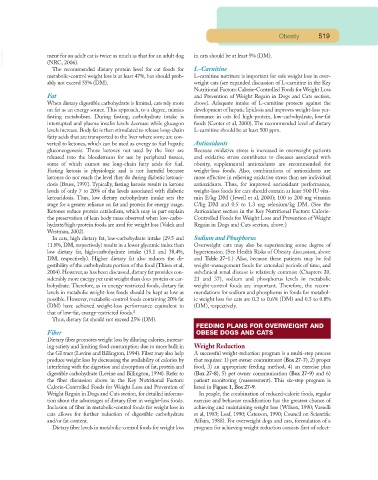Page 503 - Small Animal Clinical Nutrition 5th Edition
P. 503
Obesity 519
VetBooks.ir ment for an adult cat is twice as much as that for an adult dog in cats should be at least 5% (DM).
(NRC, 2006).
The recommended dietary protein level for cat foods for L-Carnitine
metabolic-control weight loss is at least 47%, but should prob- L-carnitine nutriture is important for safe weight loss in over-
ably not exceed 55% (DM). weight cats (see expanded discussion of L-carnitine in the Key
Nutritional Factors: Calorie-Controlled Foods for Weight Loss
Fat and Prevention of Weight Regain in Dogs and Cats section,
When dietary digestible carbohydrate is limited, cats rely more above). Adequate intake of L-carnitine protects against the
on fat as an energy source. This approach, to a degree, mimics development of hepatic lipidosis and improves weight-loss per-
fasting metabolism. During fasting, carbohydrate intake is formance in cats fed high-protein, low-carbohydrate, low-fat
interrupted and plasma insulin levels decrease while glucagon foods (Center et al, 2000). The recommended level of dietary
levels increase. Body fat is then stimulated to release long-chain L-carnitine should be at least 500 ppm.
fatty acids that are transported to the liver where some are con-
verted to ketones, which can be used as energy to fuel hepatic Antioxidants
gluconeogenesis. Those ketones not used by the liver are Because oxidative stress is increased in overweight patients
released into the bloodstream for use by peripheral tissues, and oxidative stress contributes to diseases associated with
some of which cannot use long-chain fatty acids for fuel. obesity, supplemental antioxidants are recommended for
Fasting ketosis is physiologic and is not harmful because weight-loss foods. Also, combinations of antioxidants are
ketones do not reach the level they do during diabetic ketoaci- more effective in relieving oxidative stress than are individual
dosis (Bruss, 1997). Typically, fasting ketosis results in ketone antioxidants. Thus, for improved antioxidant performance,
levels of only 7 to 20% of the levels associated with diabetic weight-loss foods for cats should contain at least 500 IU vita-
ketoacidosis. Thus, low dietary carbohydrate intake sets the min E/kg DM (Jewell et al, 2000); 100 to 200 mg vitamin
stage for a greater reliance on fat and protein for energy usage. C/kg DM and 0.5 to 1.3 mg selenium/kg DM. (See the
Ketones reduce protein catabolism, which may in part explain Antioxidant section in the Key Nutritional Factors: Calorie-
the preservation of lean body mass observed when low-carbo- Controlled Foods for Weight Loss and Prevention of Weight
hydrate/high-protein foods are used for weight loss (Volek and Regain in Dogs and Cats section, above.)
Westman, 2002).
In cats, high dietary fat, low-carbohydrate intake (29.5 and Sodium and Phosphorus
11.8%, DM, respectively) results in a lower glycemic index than Overweight cats may also be experiencing some degree of
low dietary fat, high-carbohydrate intake (15.1 and 38.4%, hypertension. (See Health Risks of Obesity discussion, above
DM, respectively). Higher dietary fat also reduces the di- and Table 27-1.) Also, because these patients may be fed
gestibility of the carbohydrate portion of the food (Thiess et al, weight-management foods for extended periods of time, and
2004).However,as has been discussed,dietary fat provides con- subclinical renal disease is relatively common (Chapters 20,
siderably more energy per unit weight than does protein or car- 21 and 37), sodium and phosphorus levels in metabolic
bohydrate. Therefore, as in energy-restricted foods, dietary fat weight-control foods are important. Therefore, the recom-
levels in metabolic weight-loss foods should be kept as low as mendations for sodium and phosphorus in foods for metabol-
possible. However, metabolic-control foods containing 20% fat ic weight loss for cats are 0.2 to 0.6% (DM) and 0.5 to 0.8%
(DM) have achieved weight-loss performance equivalent to (DM), respectively.
that of low-fat, energy-restricted foods. a
Thus, dietary fat should not exceed 25% (DM).
FEEDING PLANS FOR OVERWEIGHT AND
Fiber OBESE DOGS AND CATS
Dietary fiber promotes weight loss by diluting calories, increas-
ing satiety and limiting food consumption due to more bulk in Weight Reduction
the GI tract (Levine and Billington, 1994). Fiber may also help A successful weight-reduction program is a multi-step process
produce weight loss by decreasing the availability of calories by that requires: 1) pet owner commitment (Box 27-7), 2) proper
interfering with the digestion and absorption of fat, protein and food, 3) an appropriate feeding method, 4) an exercise plan
digestible carbohydrate (Levine and Billington, 1994). Refer to (Box 27-8), 5) pet owner communication (Box 27-9) and 6)
the fiber discussion above in the Key Nutritional Factors: patient monitoring (reassessment). This six-step program is
Calorie-Controlled Foods for Weight Loss and Prevention of listed in Figure 1, Box 27-9.
Weight Regain in Dogs and Cats section, for detailed informa- In people, the combination of reduced-calorie foods, regular
tion about the advantages of dietary fiber in weight-loss foods. exercise and behavior modification has the greatest chance of
Inclusion of fiber in metabolic-control foods for weight loss in achieving and maintaining weight loss (Wilson, 1990; Vasselli
cats allows for further reduction of digestible carbohydrate et al, 1983; Leaf, 1990; Caterson, 1990; Council on Scientific
and/or fat content. Affairs, 1988). For overweight dogs and cats, formulation of a
Dietary fiber levels in metabolic-control foods for weight loss program for achieving weight reduction consists first of select-

